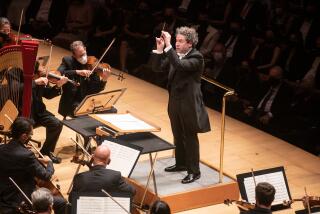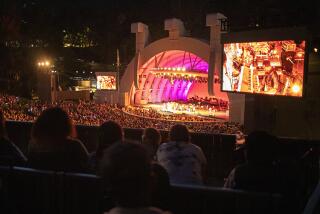Review: Balsom, Karadaglic a cool match at Hollywood Bowl

The Hollywood Bowl has always been a venue for trying out new talent. With high-definition video now part of the equation, the temptation for the Los Angeles Philharmonic to entice the most attractive young performers must be greater than ever.
Tuesday night with trumpet player Alison Balsom and guitarist Milos Karadaglic, who was making his L.A. Phil debut, the L.A. Phil went straight for marketable gold, given how both artists have been heavily promoted for their sex appeal.
They were joined, moreover, by a young conductor, Joshua Weilerstein. He may not yet have bestselling recordings on the market, but he is one of the most promising podium presences of his generation. The three of them were a gift to the Bowl’s video camera crew.
The British trumpeter, in her slender white outfit (which generated a few boorish catcalls), and the Montenegrin guitarist, in his slender black outfit, would not have looked out of place stepping off a yacht in Ibiza for a night of clubbing. But they are not to be discounted as serious artists. Each is a master of her or his instrument, with impeccable technique and a recognizable sound.
Furthermore Balsom and Karadaglic, after paying their dues making market-driven classical-lite CDs, have turned to more substantial repertory, particularly Balsom, who has added contemporary concertos to her discography. Karadaglic’s new Deutsche Grammophon disc of popular Spanish concertos by Joaquín Rodrigo is at least a start in the right direction.
Neither Balsom nor Karadaglic is flashy. And that is, ironically, where the disconnect begins. For all their technical excellence and admirable seriousness, both came off Tuesday as relatively bland musicians. Balsom’s vehicles were De Falla’s “Seven Popular Songs” — originally for mezzo-soprano and piano and here given in Luciano Berio’s arrangement for trumpet and orchestra — and tango genius Astor Piazzolla’s “Oblivion,” in an uncredited arrangement.
Karadaglic’s choice was the Rodrigo “Concierto de Aranjuez.” Then the trumpeter and guitarist joined forces for another Piazzolla tango and an arrangement (also uncredited) for trumpet, guitar and orchestra of “Autumn Leaves.”
Balsom and Karadaglic don’t really have much in common beyond a kind of interpretive coolness. His is a black-and-white style of playing that alternates between self-assured snappish strumming and crisp melodic phrasing. His tone, as illuminated by the amplification, is bell-like and strong. His Spanish style in Rodrigo’s famous score is sturdy, effective when approaching flamenco but unbending in the beloved slow movement, especially in contrast Tuesday to Carolyn Hove’s more limpid English horn solo.
Like Karadaglic, Balsom shapes each phrase carefully. But she is his opposite otherwise. She operates in subtle shades of — can we still use this metaphor? — soft gray. Her tone is eloquent in the extreme, and she varies it with finesse.
But De Falla’s songs are lusty. The Berio arrangement is a peculiarity that should be taken with a grain of salt. He wrote it for Cathy Berberian. The Italian composer and American mezzo were gloriously theatrical musicians, and although Berio made these arrangements after they had had a tempestuous divorce, the couple continued to work together.
Berio tried to stick to De Falla’s, rather than his own avant-garde style, but he couldn’t resist little digs in instrumental details, and Berberian sang them with an attitude, taking outrageous glee finding sexual double entendres.
The trumpet version is something else, an easy way for a notorious deadline junky to avoid actually writing a trumpet concerto and hustle more performances — nothing more. Balsom played with thoughtful reserve. She also seemed oblivious to the flirtatiousness of Piazzolla’s “Oblivion.”
The short duos were essentially trumpet solos with guitar accompaniment. Piazzolla’s “Cafè, 1930,” from his “Histoire du Tango” had no more frisson than “Oblivion.” But in “Autumn Leaves,” Balsom’s “Birth of the Cool” approach provided a not unwarranted chilly hipness.
As for color, that was the purview of Weilerstein and the L.A. Phil, which began the program with Zoltán Kodály’s “Dances of Galánta” and ended with Ravel’s “La Valse.” The Hungarian dances had the benefit of Weilerstein’s emotional punch and Michele Zukovsky’s gravity-defying free-form clarinet solo.
The Ravel, though, was what the evening really needed. Rather than bring out a Frenchman’s deconstruction of the Viennese waltz in the wake of World War I, a buoyant Weilerstein simply splashed the Bowl with great swathes of hot, bright orchestral pigments. Short of fireworks, this was exactly what the night needed.
More to Read
The biggest entertainment stories
Get our big stories about Hollywood, film, television, music, arts, culture and more right in your inbox as soon as they publish.
You may occasionally receive promotional content from the Los Angeles Times.







